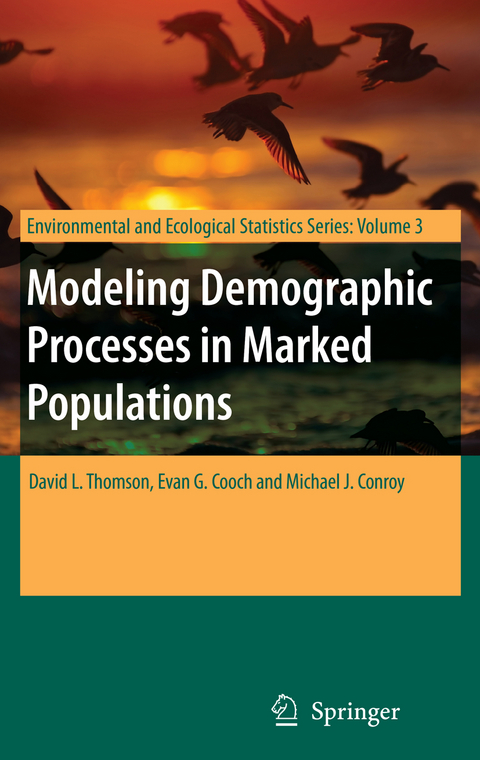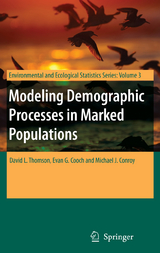Modeling Demographic Processes in Marked Populations
Seiten
2008
|
2009 ed.
Springer-Verlag New York Inc.
9780387781501 (ISBN)
Springer-Verlag New York Inc.
9780387781501 (ISBN)
Here, biologists and statisticians come together in an interdisciplinary synthesis with the aim of developing new methods to overcome the most significant challenges and constraints faced by quantitative biologists seeking to model demographic rates.
Demography can be considered the key to understanding much of biology. It is the demographic processes of birth and death which govern the spread of populations through environmentsand the spread of genes through populations. An understa- ing of demographycan yield not only an understanding of population size and p- ulation change, it can help us to understand the form and function of life histories; whenorganismsmature,whentheybreed,and whentheydie. Demographicinsights allow us to see how populations function, how they interact with their changing environment, and how they adapt. The analysis of demographic processes in free-living organisms is however no simple task and involves considerable challenges in observation and analysis. Some 20yearsago,therewasaconcertedefforttopromoteinter-disciplinarycollaboration between biologists and statisticians to address these challenges and thereby to f- ther our understanding of demographic processes in natural populations. Although many diverse organisms can be studied in the wild, birds have proved particularly amenable with large numbers being marked and followed by large networks of - servers.
Itwas nocoincidencethenthatthe EuropeanUnionforBird Ringing(EUR- ING) played a leading role in these initiatives, teaming up in the mid-1980swith the Mathematical Ecology Group of the Biometric Society, and the British Ecological Society, to bring together experts from diverse ?elds to address the challenges in hand. Twenty years on, progresshas been considerable and we now have signi?cant insights into demographic processes thanks to the wide range of quantitative tools and systematically collected datasets which have been built up over this period.
Demography can be considered the key to understanding much of biology. It is the demographic processes of birth and death which govern the spread of populations through environmentsand the spread of genes through populations. An understa- ing of demographycan yield not only an understanding of population size and p- ulation change, it can help us to understand the form and function of life histories; whenorganismsmature,whentheybreed,and whentheydie. Demographicinsights allow us to see how populations function, how they interact with their changing environment, and how they adapt. The analysis of demographic processes in free-living organisms is however no simple task and involves considerable challenges in observation and analysis. Some 20yearsago,therewasaconcertedefforttopromoteinter-disciplinarycollaboration between biologists and statisticians to address these challenges and thereby to f- ther our understanding of demographic processes in natural populations. Although many diverse organisms can be studied in the wild, birds have proved particularly amenable with large numbers being marked and followed by large networks of - servers.
Itwas nocoincidencethenthatthe EuropeanUnionforBird Ringing(EUR- ING) played a leading role in these initiatives, teaming up in the mid-1980swith the Mathematical Ecology Group of the Biometric Society, and the British Ecological Society, to bring together experts from diverse ?elds to address the challenges in hand. Twenty years on, progresshas been considerable and we now have signi?cant insights into demographic processes thanks to the wide range of quantitative tools and systematically collected datasets which have been built up over this period.
Population Dynamics – Growth, Density-Dependence and Decomposing ?.- Evolutionary Ecology.- Abundance Estimation – Direct Methods, Proxies, Occupancy Models and Point Count Data.- Dispersal, Movement and Migration – Methods and Multi-State Models.- Wildlife and Conservation Management.- Combing Sources of Information – Kalman Filters, Matrix Methods and Joint Likelihoods.- Bayesian Applications - Advances, Random Effects and Hierarchical Models.- The Robust Design – Sampling, Applications and Advances.- State Uncertainty – Assignmant Error and Unobservable States.- New Software Developments for Modeling Demographic Processes.- Open Forum.
| Erscheint lt. Verlag | 2.12.2008 |
|---|---|
| Reihe/Serie | Environmental and Ecological Statistics ; 3 |
| Zusatzinfo | XXIV, 1132 p. |
| Verlagsort | New York, NY |
| Sprache | englisch |
| Maße | 156 x 235 mm |
| Themenwelt | Mathematik / Informatik ► Mathematik ► Wahrscheinlichkeit / Kombinatorik |
| Medizin / Pharmazie | |
| Sozialwissenschaften ► Soziologie ► Empirische Sozialforschung | |
| ISBN-13 | 9780387781501 / 9780387781501 |
| Zustand | Neuware |
| Informationen gemäß Produktsicherheitsverordnung (GPSR) | |
| Haben Sie eine Frage zum Produkt? |
Mehr entdecken
aus dem Bereich
aus dem Bereich
Stochastik: von Abweichungen bis Zufall
Buch | Softcover (2025)
De Gruyter (Verlag)
CHF 48,90
Buch | Softcover (2024)
Springer Spektrum (Verlag)
CHF 69,95




